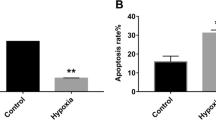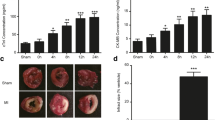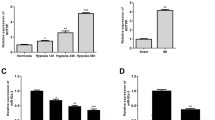Abstract
Myocardial infarction is one of the most lethal diseases in cardiovascular diseases. In the present work, we aimed to elucidate the molecular and functional association long non-coding RNA (lncRNA) X-inactive specific transcript (XIST), microRNA (miR)-191-5p, and TNF receptor-associated factor 3 (TRAF3). Human cardiomyocyte primary cells (HCMs) were stimulated by hypoxia to establish a model of myocardial injury in vitro. The relative expressions of XIST, miR-191-5p, and TRAF3 were measured using quantitative real-time polymerase chain reaction (qRT-PCR) assay. The capabilities of proliferation and apoptosis were determined using cell counting kit (CCK-8) and flow cytometry assays, respectively. The molecular interactions were verified using dual luciferase assay. The protein contents of TRAF3, Bcl-2, and Bax were calculated using western blot assay. XIST was significantly increased, but miR-191-5p was reduced in hypoxia-treated HCMs compared to that in control group. Either downregulated XIST or enforced miR-191-5p markedly enhanced cell viability and restrained cell apoptotic rate in hypoxia-treated HCMs. Mechanistically, XIST directly interacted with miR-191-5p to competitive releasing TRAF3 expression. Importantly, overexpression of TRAF3 dramatically diminished the protective effects of XIST knockdown on hypoxia-triggered HCMs injury. Collectively, our data elucidated a novel “lncRNA XIST/miR-191-5p/TRAF3” molecular network in vitro, indicating that the reduced lncRNA XIST-protected HCMs from hypoxia-induced cell injury by regulating miR-191-5p/TRAF3 signaling, which might provide some convincing evidences for further understanding the influences of “lncRNA-miRNA-mRNA” network in the development of MI.






Similar content being viewed by others
Data availability
The datasets used or analyzed during the current study are available from the corresponding author on reasonable request.
Code availability
Not applicable.
References
Mullasari AS, Balaji P, Khando T (2011) Managing complications in acute myocardial infarction. J Assoc Physicians India 59(Suppl):43–48
Kim Y, Sharp S, Hwang S, Jee SH (2019) Exercise and incidence of myocardial infarction, stroke, hypertension, type 2 diabetes and site-specific cancers: prospective cohort study of 257 854 adults in South Korea. BMJ Open 9:e025590. https://doi.org/10.1136/bmjopen-2018-025590
Ben-Yehuda O, Chen S, Redfors B, McAndrew T, Crowley A, Kosmidou I, Kandzari DE, Puskas JD, Morice MC, Taggart DP, Leon MB, Lembo NJ, Brown WM, Simonton CA, Dressler O, Kappetein AP, Sabik JF, Serruys PW, Stone GW (2019) Impact of large periprocedural myocardial infarction on mortality after percutaneous coronary intervention and coronary artery bypass grafting for left main disease: an analysis from the EXCEL trial. Eur Heart J 40:1930–1941. https://doi.org/10.1093/eurheartj/ehz113
Crossman AW, D’Agostino HJ Jr, Geraci SA (2002) Timing of coronary artery bypass graft surgery following acute myocardial infarction: a critical literature review. Clin Cardiol 25:406–410. https://doi.org/10.1002/clc.4960250903
Sorensen JT, Maeng M (2015) Regional systems-of-care for primary percutaneous coronary intervention in ST-elevation myocardial infarction. Coron Artery Dis 26:713–722. https://doi.org/10.1097/MCA.0000000000000290
Mujalli A, Banaganapalli B, Alrayes NM, Shaik NA, Elango R, Al-Aama JY (2020) Myocardial infarction biomarker discovery with integrated gene expression, pathways and biological networks analysis. Genomics 112:5072–5085. https://doi.org/10.1016/j.ygeno.2020.09.004
Wu Z, Su X, Sheng H, Chen Y, Gao X, Bao L, Jin W (2017) Conditional inference tree for multiple gene-environment interactions on myocardial infarction. Arch Med Res 48:546–552. https://doi.org/10.1016/j.arcmed.2017.12.001
Galupa R, Heard E (2018) X-chromosome inactivation: a crossroads between chromosome architecture and gene regulation. Annu Rev Genet 52:535–566. https://doi.org/10.1146/annurev-genet-120116-024611
Liu CY, Zhang YH, Li RB, Zhou LY, An T, Zhang RC, Zhai M, Huang Y, Yan KW, Dong YH, Ponnusamy M, Shan C, Xu S, Wang Q, Zhang YH, Zhang J, Wang K (2018) LncRNA CAIF inhibits autophagy and attenuates myocardial infarction by blocking p53-mediated myocardin transcription. Nat Commun 9:29. https://doi.org/10.1038/s41467-017-02280-y
Zhang BF, Jiang H, Chen J, Hu Q, Yang S, Liu XP, Liu G (2020) LncRNA H19 ameliorates myocardial infarction-induced myocardial injury and maladaptive cardiac remodelling by regulating KDM3A. J Cell Mol Med 24:1099–1115. https://doi.org/10.1111/jcmm.14846
Liu J, Yao L, Zhang M, Jiang J, Yang M, Wang Y (2019) Downregulation of LncRNA-XIST inhibited development of non-small cell lung cancer by activating miR-335/SOD2/ROS signal pathway mediated pyroptotic cell death. Aging (Albany NY) 11:7830–7846. https://doi.org/10.18632/aging.102291
Wei W, Liu Y, Lu Y, Yang B, Tang L (2017) LncRNA XIST promotes pancreatic cancer proliferation through miR-133a/EGFR. J Cell Biochem 118:3349–3358. https://doi.org/10.1002/jcb.25988
Zhu H, Zheng T, Yu J, Zhou L, Wang L (2018) LncRNA XIST accelerates cervical cancer progression via upregulating Fus through competitively binding with miR-200a. Biomed Pharmacother 105:789–797. https://doi.org/10.1016/j.biopha.2018.05.053
Sheng X, Fan T, Jin X (2020) Identification of key genes involved in acute myocardial infarction by comparative transcriptome analysis. Biomed Res Int 2020:1470867. https://doi.org/10.1155/2020/1470867
Zhang J, Wang Q, Quan Z (2019) Long non-coding RNA CASC9 enhances breast cancer progression by promoting metastasis through the meditation of miR-215/TWIST2 signaling associated with TGF-beta expression. Biochem Biophys Res Commun 515:644–650. https://doi.org/10.1016/j.bbrc.2019.05.080
Condorelli G, Latronico MV, Cavarretta E (2014) microRNAs in cardiovascular diseases: current knowledge and the road ahead. J Am Coll Cardiol 63:2177–2187. https://doi.org/10.1016/j.jacc.2014.01.050
Saliminejad K, Khorram Khorshid HR, Soleymani Fard S, Ghaffari SH (2019) An overview of microRNAs: Biology, functions, therapeutics, and analysis methods. J Cell Physiol 234:5451–5465. https://doi.org/10.1002/jcp.27486
Boon RA, Dimmeler S (2015) MicroRNAs in myocardial infarction. Nat Rev Cardiol 12:135–142. https://doi.org/10.1038/nrcardio.2014.207
Sun T, Dong YH, Du W, Shi CY, Wang K, Tariq MA, Wang JX, Li PF (2017) The role of microRNAs in myocardial infarction: from molecular mechanism to clinical application. Int J Mol Sci. https://doi.org/10.3390/ijms18040745
Zheng HF, Sun J, Zou ZY, Zhang Y, Hou GY (2019) MiRNA-488-3p suppresses acute myocardial infarction-induced cardiomyocyte apoptosis via targeting ZNF791. Eur Rev Med Pharmacol Sci 23:4932–4939. https://doi.org/10.26355/eurrev_201906_18083
Li C, Chen X, Huang J, Sun Q, Wang L (2015) Clinical impact of circulating miR-26a, miR-191, and miR-208b in plasma of patients with acute myocardial infarction. Eur J Med Res 20:58. https://doi.org/10.1186/s40001-015-0148-y
Hsu A, Chen SJ, Chang YS, Chen HC, Chu PH (2014) Systemic approach to identify serum microRNAs as potential biomarkers for acute myocardial infarction. Biomed Res Int 2014:418628. https://doi.org/10.1155/2014/418628
Ashley Z, Schwenke DO, Cragg PA (2015) Hyperventilation in normoxia following myocardial infarction in rats: a shift in the set point of the hypoxic ventilatory response. Acta Physiol (Oxf) 214:415–425. https://doi.org/10.1111/apha.12527
Xie C, Qi H, Huan L, Yang Y (2020) Effect of miR-195-5p on cardiomyocyte apoptosis in rats with heart failure by regulating TGF-beta1/Smad3 signaling pathway. Biosci Rep. https://doi.org/10.1042/BSR20200566
Shu L, Zhang W, Huang C, Huang G, Su G, Xu J (2020) lncRNA ANRIL protects H9c2 cells against hypoxia-induced injury through targeting the miR-7-5p/SIRT1 axis. J Cell Physiol 235:1175–1183. https://doi.org/10.1002/jcp.29031
Lim GB (2017) Acute coronary syndromes: Supplemental oxygen in myocardial infarction. Nat Rev Cardiol 14:632. https://doi.org/10.1038/nrcardio.2017.143
Nuding S, Werdan K, Prondzinsky R (2018) Optimal course of treatment in acute cardiogenic shock complicating myocardial infarction. Expert Rev Cardiovasc Ther 16:99–112. https://doi.org/10.1080/14779072.2018.1425141
Teng Y, Ding M, Wang X, Li H, Guo Q, Yan J, Gao L (2020) LncRNA RMRP accelerates hypoxia-induced injury by targeting miR-214-5p in H9c2 cells. J Pharmacol Sci 142:69–78. https://doi.org/10.1016/j.jphs.2019.07.014
Hu H, Wu J, Li D, Zhou J, Yu H, Ma L (2018) Knockdown of lncRNA MALAT1 attenuates acute myocardial infarction through miR-320-Pten axis. Biomed Pharmacother 106:738–746. https://doi.org/10.1016/j.biopha.2018.06.122
Lin B, Xu J, Wang F, Wang J, Zhao H, Feng D (2020) LncRNA XIST promotes myocardial infarction by regulating FOS through targeting miR-101a-3p. Aging (Albany NY) 12:7232–7247. https://doi.org/10.18632/aging.103072
Wang D, Tang L, Wu Y, Fan C, Zhang S, Xiang B, Zhou M, Li X, Li Y, Li G, Xiong W, Zeng Z, Guo C (2020) Abnormal X chromosome inactivation and tumor development. Cell Mol Life Sci 77:2949–2958. https://doi.org/10.1007/s00018-020-03469-z
Czerminski JT, Lawrence JB (2020) Silencing trisomy 21 with XIST in neural stem cells promotes neuronal differentiation. Dev Cell 52(294–308):e3. https://doi.org/10.1016/j.devcel.2019.12.015
Wang K, Li Y, Qiang T, Chen J, Wang X (2021) Role of epigenetic regulation in myocardial ischemia/reperfusion injury. Pharmacol Res 170:105743. https://doi.org/10.1016/j.phrs.2021.105743
Chen Z, Zhang Y (2020) Maternal H3K27me3-dependent autosomal and X chromosome imprinting. Nat Rev Genet 21:555–571. https://doi.org/10.1038/s41576-020-0245-9
Yang X, Zhang S, He C, Xue P, Zhang L, He Z, Zang L, Feng B, Sun J, Zheng M (2020) METTL14 suppresses proliferation and metastasis of colorectal cancer by down-regulating oncogenic long non-coding RNA XIST. Mol Cancer 19:46. https://doi.org/10.1186/s12943-020-1146-4
Huang Y (2018) The novel regulatory role of lncRNA-miRNA-mRNA axis in cardiovascular diseases. J Cell Mol Med 22:5768–5775. https://doi.org/10.1111/jcmm.13866
Yang X, Du X, Ma K, Li G, Liu Z, Rong W, Miao H, Zhu F, Cui Q, Wu S, Li Y, Du J (2021) Circulating miRNAs related to long-term adverse cardiovascular events in STEMI patients: a nested case-control study. Can J Cardiol 37:77–85. https://doi.org/10.1016/j.cjca.2020.03.018
Liu X, Xiao J, Zhu H, Wei X, Platt C, Damilano F, Xiao C, Bezzerides V, Bostrom P, Che L, Zhang C, Spiegelman BM, Rosenzweig A (2015) miR-222 is necessary for exercise-induced cardiac growth and protects against pathological cardiac remodeling. Cell Metab 21:584–595. https://doi.org/10.1016/j.cmet.2015.02.014
Poller W, Dimmeler S, Heymans S, Zeller T, Haas J, Karakas M, Leistner DM, Jakob P, Nakagawa S, Blankenberg S, Engelhardt S, Thum T, Weber C, Meder B, Hajjar R, Landmesser U (2018) Non-coding RNAs in cardiovascular diseases: diagnostic and therapeutic perspectives. Eur Heart J 39:2704–2716. https://doi.org/10.1093/eurheartj/ehx165
Yi Z, Wallis AM, Bishop GA (2015) Roles of TRAF3 in T cells: many surprises. Cell Cycle 14:1156–1163. https://doi.org/10.1080/15384101.2015.1021524
Bishop GA, Stunz LL, Hostager BS (2018) TRAF3 as a multifaceted regulator of B lymphocyte survival and activation. Front Immunol 9:2161. https://doi.org/10.3389/fimmu.2018.02161
Sun SC (2012) The noncanonical NF-kappaB pathway. Immunol Rev 246:125–140. https://doi.org/10.1111/j.1600-065X.2011.01088.x
Zhao G, Hailati J, Ma X, Bao Z, Bakeyi M, Liu Z (2020) LncRNA Gm4419 regulates myocardial ischemia/reperfusion injury through targeting the miR-682/TRAF3 axis. J Cardiovasc Pharmacol 76:305–312. https://doi.org/10.1097/FJC.0000000000000867
Funding
None.
Author information
Authors and Affiliations
Contributions
YW: Conceptualization, Methodology, Validation, Writing—Original draft preparation; YL: Data curation; AF: Visualization and Investigation; ZY: Supervision, Writing—Reviewing and Editing.
Corresponding author
Ethics declarations
Conflict of interest
The authors declare that they have no conflict of interest.
Ethical approval
Not applicable.
Research involving human and animal rights
This article does not contain any studies with human participants or animals performed by any of the authors.
Consent for publication
Not applicable.
Additional information
Publisher's Note
Springer Nature remains neutral with regard to jurisdictional claims in published maps and institutional affiliations.
Supplementary Information
Below is the link to the electronic supplementary material.
11010_2022_4385_MOESM1_ESM.tif
Figure S1 XIST overexpression inhibited HCM cell proliferation HCMs were transfected with empty vector or XIST overexpression vector. (A) Cell viability was evaluated by CCK-8 assay. (B) Cell apoptosis was assessed by flow cytometry assay. *P <0.05, **P <0.01. (TIF 8459 kb)
11010_2022_4385_MOESM2_ESM.tif
Figure S2 miR-191-5p overexpression ameliorated hypoxia-induced cell injury in HCM via repressing TRAF3 HCMs were divided into 4 group: control, hypoxia + mimics NC, hypoxia + 191-5p mimics, hypoxia + 191-5p mimics + pcDNA3.1-TRAF3. The mRNA (A) and protein (B) level of TRAF3 was detected by qRT-PCR assay and western blot, respectively. (C) Cell viability was evaluated by CCK-8 assay. (D) Cell apoptosis was assessed by flow cytometry assay. (E) Levels of apoptosis-associated proteins were tested by western blot assay. *P <0.05, **P <0.01. (TIF 53447 kb)
Rights and permissions
About this article
Cite this article
Wang, Y., Liu, Y., Fei, A. et al. LncRNA XIST facilitates hypoxia-induced myocardial cell injury through targeting miR-191-5p/TRAF3 axis. Mol Cell Biochem 477, 1697–1707 (2022). https://doi.org/10.1007/s11010-022-04385-5
Received:
Accepted:
Published:
Issue Date:
DOI: https://doi.org/10.1007/s11010-022-04385-5




